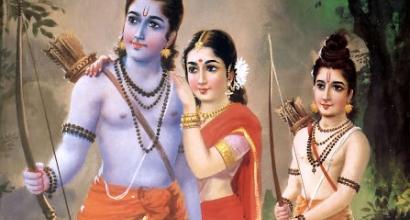Phonetic languages have two major purposes – one is related to the realm of emotion (bhāvopayoga[1]) and the other to the material world (bhavopayoga). We do not consider classical arts such as dance and music as media for communicating information. Spoken language, which is the medium of our everyday communication, is mostly expected to provide us with information, while the same phonetic language, taking the form of poetry and story becomes non-utilitarian. Art is different from the material world and is not meant to communicate information. A dance number performed on a given day can be repeated the following day and a rāga that was rendered the previous year can be presented the following year too, without causing any boredom to the audience. Raw information, that naturally grows stale with time, is not meant to be communicated through these forms of classical art; therefore, anything expressed through the classical medium always remains fresh. If art is (mis-)used to communicate mere facts, it becomes quantified and loses its subtle nature. Can the rendition of a rāga or dancing to a tāla directly bring about social or environmental revolution? Can it help in economic progress? It would be ridiculous to expect them to do so. They are meant for aesthetic pleasure only.
Applied arts have a few more possibilities compared to the classical arts. These possibilities, which at times diverge from the primary purpose of art can be justified to some extent as well. That said, artistes who practice applied arts must never forget that the competence they have developed is because of their roots in classicism. Classical art can be likened to pure science and applied art to technology. Classical art is rejuvenation of life and not the production of a living. When such is the case, what is the absolute purpose of ‘pure’, ‘fine’ or ‘classical’ art? What does art do? It does nothing and that is what it does! In other words, art transcends all purposes.
The Nāṭyaśāstra says, viśrānti jananaṃ loke nāṭyam-etad-bhaviṣyati (1.11). Nāṭya is supposed to help us experience undisturbed peace. Whatever rids us of our mental or physical weariness qualifies as the means for attaining tranquility. The joy that is experienced by the connoisseur while witnessing a piece of art is not as universal or unblemished as the experience of deep sleep but it is the best he can get in his wakeful state. The purpose of art is to evoke this kind of joy in the heart of the connoisseur. It is for this reason that nāṭya and other forms of theatrical art are called keli, i.e., sport. Even to this day, the presentation of Yakṣagāna is called āṭa in the Kannada language, meaning, a game. The term used for the rendition of Hindustani music is khyāl, a word derived from the term khela, which means to play. What’s more, all activities of the divine are considered his games. Words such as vinoda, khelana, līlā and krīḍā are used in the Vedas and the purāṇas to describe the working of the Paramātmā. The Indian tradition has, thus, sublimated the world and has considers it a divine play.
People typically resort to art because they need respite from the daily torments of the material world. Would they enjoy theatre art if the world were to be replicated in all its rawness there too? How many will watch a theatrical performance that is only an imitation of the world? How long will they watch it? Even if the theatrical performance addresses a particular social issue or a political problem of great concern, people may watch it once. It is unlikely that they will watch it over and over again. It is a well-known fact that nṛtta (pure dance), rāgālāpana (elaboration of a rāga), and the play of beautiful lines and colours evoke joy in the connoisseur even though they all are non-referential in nature. They neither narrate a story nor have an embedded theme; they are ‘pure’ forms of art, unalloyed by any kind of ‘content’.
Millions of people throng movie theatres to derive pleasure. The kind of movies that people typically watch certainly possess a storyline and engaging content. We’ve seen that many movies that do not give a ‘message’ are extremely successful as well. Why is this so? If we take a moment to contemplate upon the nature of art with these points in view, we will realise the true purpose of art. If we find that art provides solutions to the problems we face in our daily life, it is largely because of its suggestive nature. It could also be due to the talent of the artiste. This, in fact, holds true with all classical forms of art.
Art provides lung-space to the life of its connoisseurs. In other words, it gives a moment of fresh oxygen amidst a polluted environment. It is not correct to expect any kind of social message or therapeutic value from art in general, and Indian art in particular. From the earliest times, art in India has been considered a source of enjoyment and relish. Any refinement of the individual or society that might happen because of the presence of an art form is merely incidental, a by-product of art. Beauty has no purpose other than causing delight to its viewer. These concepts are, indeed, familiar to an artiste who is true to his experience.
Some scholars and aestheticians opine that while the ultimate purpose of art is to evoke Ānanda (Absolute Joy), propounding values is also equally important. One of the popular views states that art should ‘produce joy accompanied with values.’ The import of this statement is that wherever Joy is evoked, human values naturally follow. We are not trying to say that values are inevitable for Joy. Ānanda, the Ultimate Value is independent of all constraints of space and time. There is no point in arguing that art should cater to every problem in the world and that it should have a certain structure to do so. If a person wants ‘education’ or ‘instruction’ as the end product of his activity, he can choose from various modes of communication, such as a speech, essay, or a newspaper article. More importantly, we are being myopic if we limit every activity by looking at it only from the perspective of the material product it delivers; for, utilitarianism in every aspect of life makes it unidimensional. Art, on the other hand, transcends all purposes and delivers the Ultimate Value – Ānanda.
To be continued...
This series of articles is authored by Shatavadhani Dr. R Ganesh and have been rendered into English with additional material and footnotes by Arjun Bharadwaj. The article first appeared in the second edition of the anthology Prekṣaṇīyaṃ, published by the Prekshaa Pratishtana in December 2022.
[1] Bhāva means emotion and bhava means the material world











































